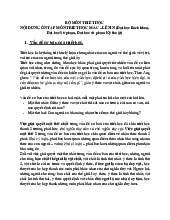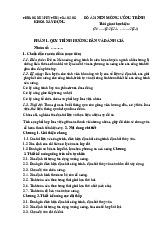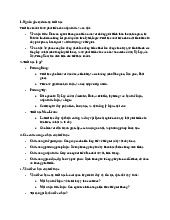



Preview text:
lOMoAR cPSD| 41487872 Đề thi Marketing 3 câu 3 – 3 – 4 2 câu lý thuyết Ví dụ 0.5 Điểm
Câu 4 điểm là câu vận dụng, áp vào trường hợp thực tế, phân tích SWOT cho
1 trường hợp nào đó, phân tích pest down
Trước khi apply swot vào case thì cần giải thích swot là cái gì, swot thường được áp
dụng trong trường hợp nào/ phần nào trong chiến dịch truyền thông Marketing.
2 phần nhiều: Tổng quan mkt, cạnh tranh thị
trường Tóm gọn 4E và vận dụng của từng ý
?1: Marketing defini/ the nature of marketing state/ 5 Marketing orientation I. Definitions
1. According to CIM (the Chartered Institution of Marketing): “The
management process which identifies, anticipates, and supplies customer
requirements efficently and profitably”
2. According to AMA (The American Marketing association): “Marketing
is the activity, set of intitutions, and processes for creating
(already posted in docs, read and cut be4)
II. Understand the nature of Marketing (chính là bản chất của defi bên trên)
Marketing is aimed at effectively and beneficially identifying, predicting
and responding to customer requirements.
Marketing is the conduct of business activities directly related from the flow of goods to consumers.
Marketing is the process of working with the market to make exchanges
to satisfy people's needs and wants.
Marketing is a form of human activity (including organization), to satisfy
needs and wants through communication.
III. Marketing orientation (tí cap lại trong video)
Phân tích ví dụ (nửa trang giấy) hoặc lOMoAR cPSD| 41487872
- Có thể phân tích ví dụ tổng thì viết dài 1 chút, phân tích 1 quan điểm/ 1 case
- Hoặc với mỗi một quan điểm sẽ cho 1 case vào thì dung lượng sẽ là 1-2 ý ?2: The history of Marketing
- Chỉ cần có cung cầu thì sẽ có marketing -> phân tích relationship, gth các cuộc
cm công nghiệp trước và sau tk 20 - Mốc ở VN: 1980 và 1990
?3: Concepts of Needs, Wants, Requirements
- Defi needs + tháp nhu cầu mashlow, mỗi bậc cần phân tích theo ý hiểu và cho
ví dụ, không viết quá dài - wants: - requirements
Needs is defined by Philip Kotler: “A human need is a state, a sense of
lack of some fundamental satisfaction”
Psychologist Maslow constructed Maslow’s
Tower of Needs in 1943 to show the levels of
human needs, going from the most basic to the higher order of needs
o Physiological needs: are the most basic
and essential needs of humans,
including the needs for food and
water, air, sleep, clothing and shelter.
These are the needs that, if not fully
met, will seriously affect human health
and survival. Meeting physiological
needs is a prerequisite (a necessity) for
humans to survive and develop.
Physiological needs are the bottom
level, according to Maslow, only when
this level of physiological needs, can
each person reach the next levels in the tower model. lOMoAR cPSD| 41487872
o Safety needs: is the need to feel safe and protected from possible
dangers. This need includes physical, mental and social safety.
The need for safety is the second level in Maslow’s hierarchy of needs. This need includes:
Physical safety: including the need for safe accommodation,
protection from food, water, medical and environmental
risks. People need to feel that they and their families are
protected from the risks of disasters and property damage
Mental safety: the need to feel safe mentally and socially.
People need to feel that they are not threatened by
conflict, violence. They hope to have a stable and safe
social environment to develop and express themselves.
Social security: the necessary to protect oneself from social
hazards such as violence and injustice, …
Once the physiological needs are met, people will begin to pay
attention to the safety needs. Meeting the need of security will make
people feel at ease and comfortable, so they can focus on developing higher demand.
o Belonging Needs: After satisfying physical needs, each person will
want to meet spiritual needs. At this third level, spiritual satisfaction
needs begin to appear. This need is the desire to expand relationships
such as: family, friend, love, … in order to eliminate the feeling of
loneliness and sadness when being alone, and bringing familiarity.
For example: A new employee will care about the salary to meet the
needs of accommodation, food, warm clothing, ... then consider
whether the work environment is safe or not, is there any insurance?
When all these things are satisfied, that individual will expand their
social relationships with colleagues and customers to better
integrate and complete their work.
o Esteem needs: the need for esteem in Maslow’s hierarchy of needs
represents the desire to receive respect from others. When at this
level, each person will constantly strive to receive respect from the
outside. The most obvious manifestations of this need include:
The desire for reputation and respect from
outside: reputation, status, level of success
Self-esteem: shown in a person who value their own morality and dignity lOMoAR cPSD| 41487872
o Self-actualization needs: are the highest level of Maslow’s
hierarchy of needs, representing personal advancement and
development to reach the peak of each person’s potential. This
position appears when fulfilling the other 4 positions, however,
there is a difference from the previous 4 needs: it doesn’t come
from shortages but from everyone’s development aspirations.
Wants: are desires to acquire specific things to satisfy deeper needs. The
same needs, but depending on each person, there are different specific
wants. Human wants are constantly developing and are shaped by social
forces and institutions such as schools, families, companies, churches,… A
want is not always present and it can change frequently. Marketers need to
identify the internal and external impacts that affect the wishes of
customers, so they can gain a deeper understanding of them and have better response
Requirement: is the desire to acquire ……. Individual has sufficient
resources and attitudes to carry out the buying behavior. Thus, a desire can
only become a requirement when we are able to afford it and are willing to
pay. Marketing people, along with other factors in society, influence wants
and needs by creating products that are relevant, easy to find, attractive
and affordable for their target customers. The more the product satisfies
the wants and needs of the target customers, the more successful the marketer will be. ILLUSTRATIVE EXAMPLES




